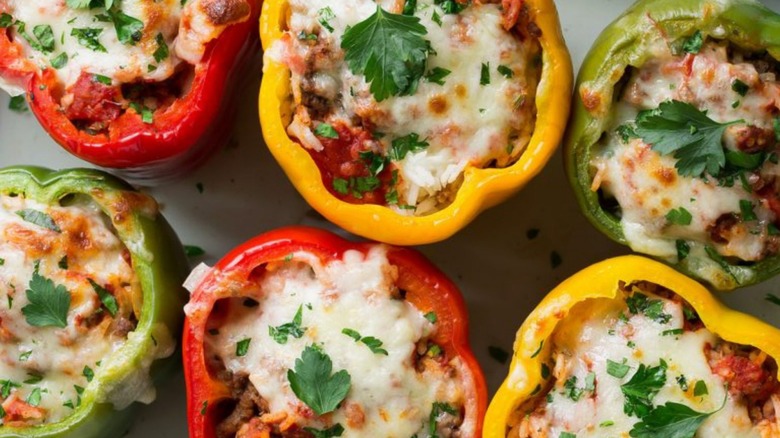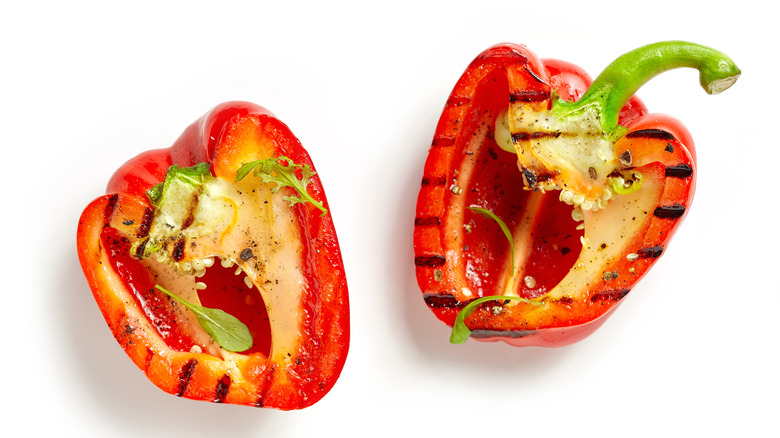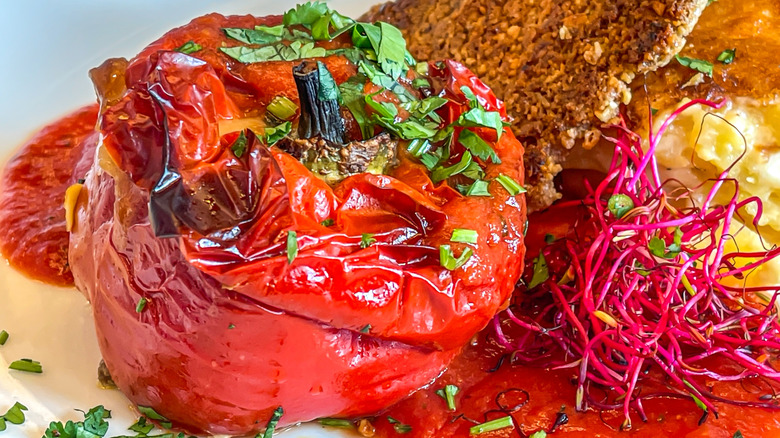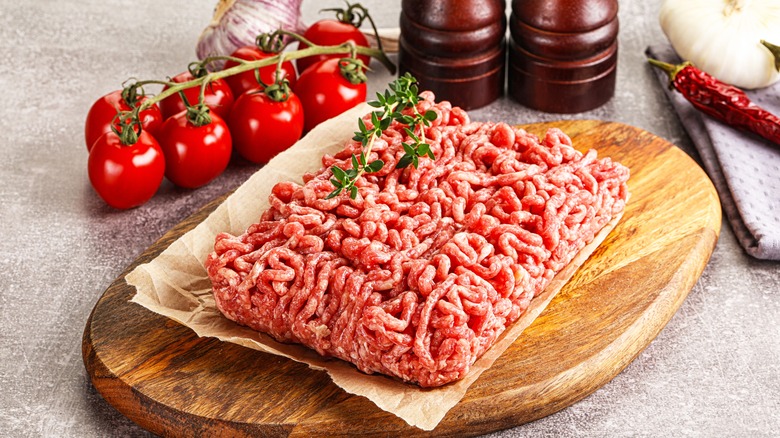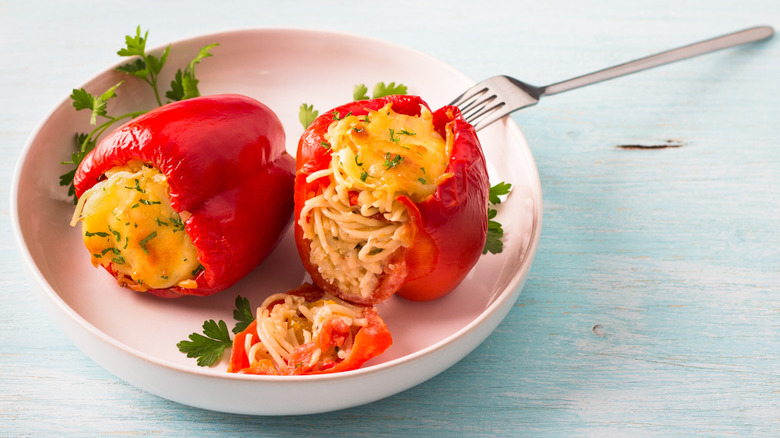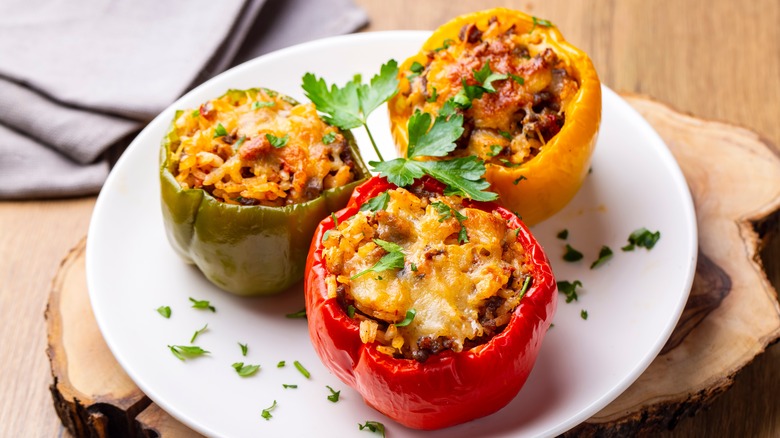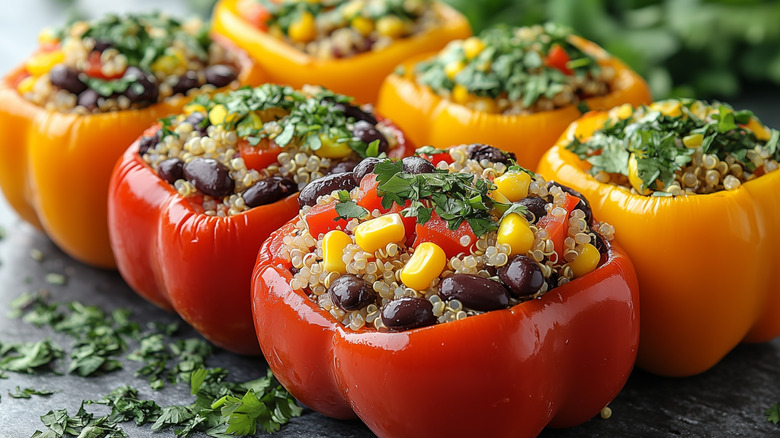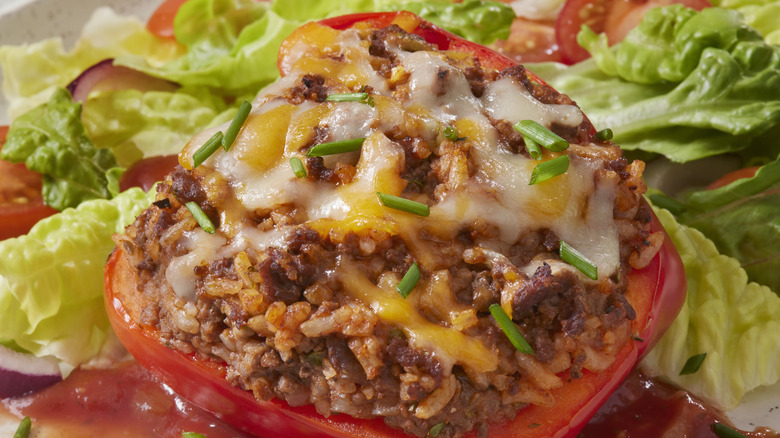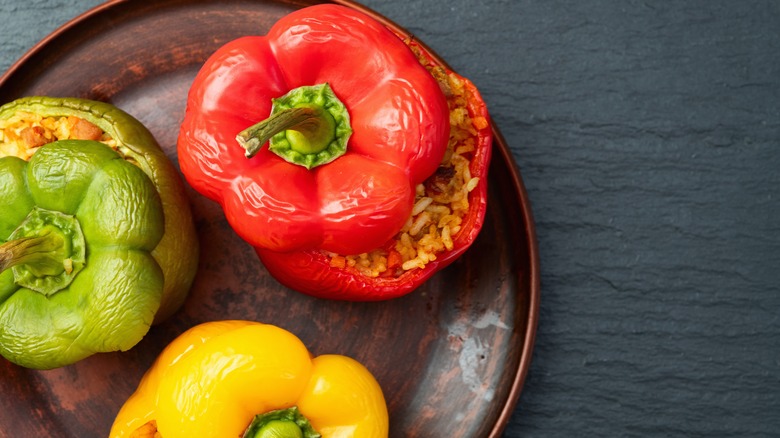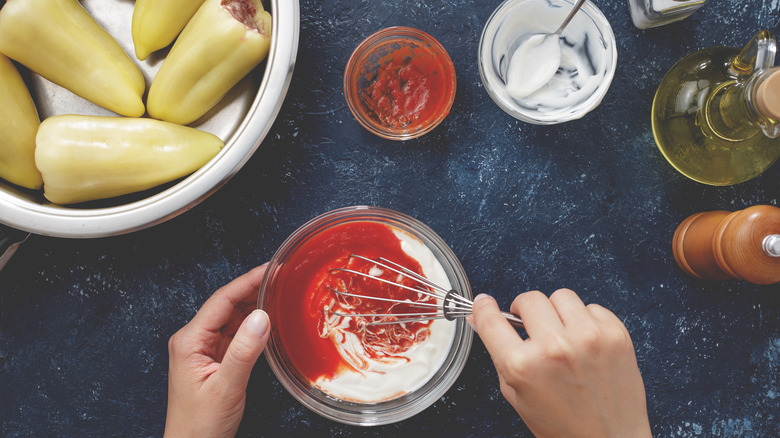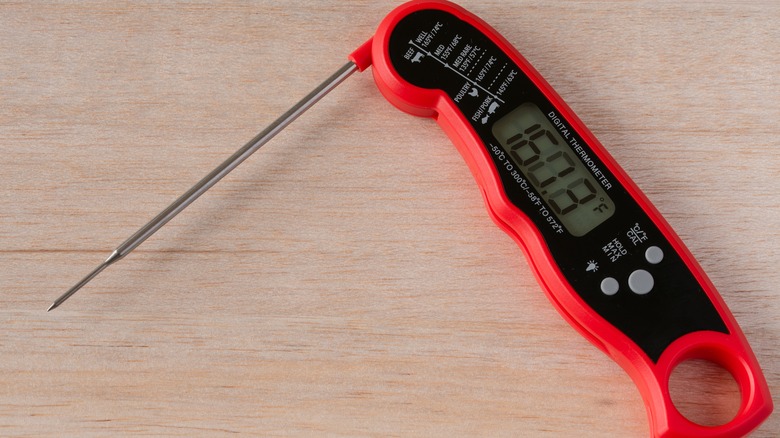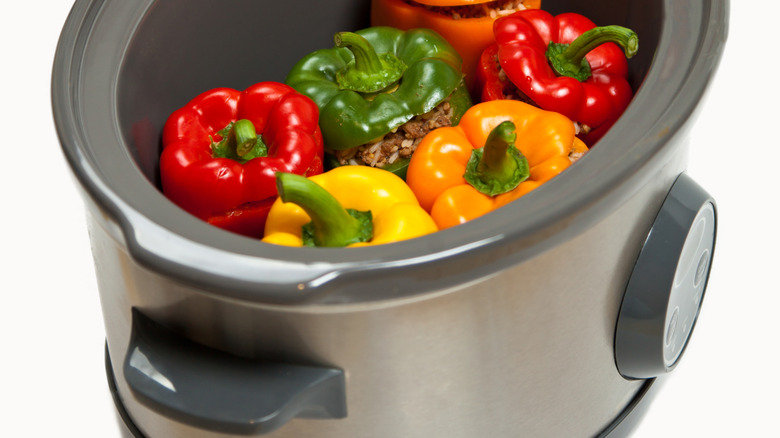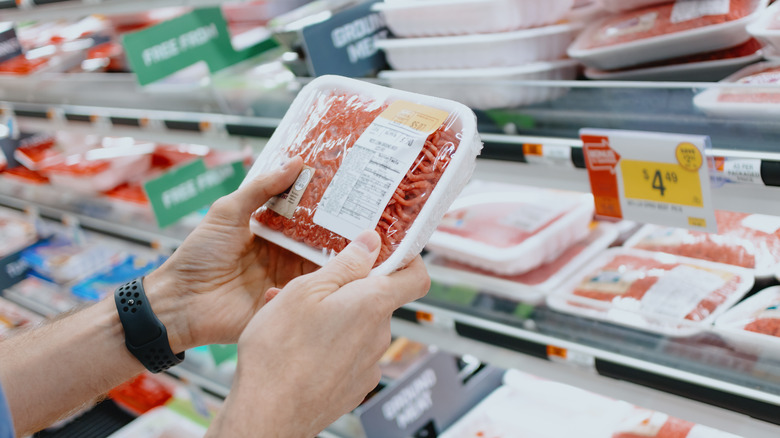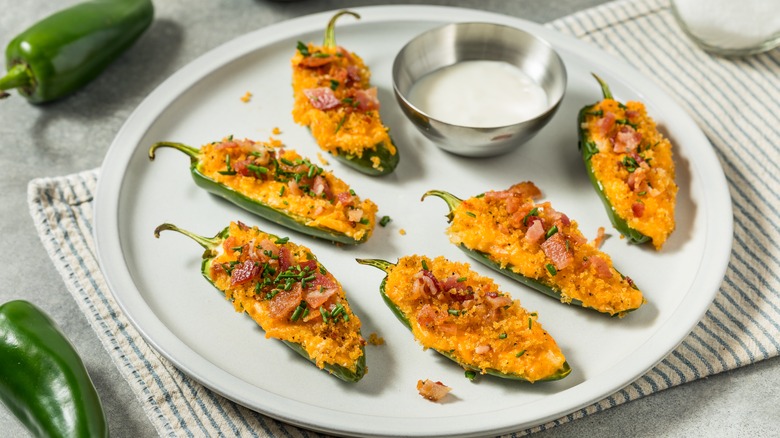13 Mistakes Everyone Makes Cooking Stuffed Peppers
The basic stuffed bell pepper recipe features a ground beef, rice, and tomato sauce filling stuffed into a pepper with cheese melted over the top. Sometimes onions and peppers are added to the mix too. Either way, it's a dish that keeps people coming back for more. The fun doesn't have to stop with the basic recipe either. However, if you've ever attempted to make stuffed bell peppers and they didn't turn out how you wanted — maybe because you wound up with an overflowing mess, split peppers, or something else, don't worry.
While the recipe seems pretty simple at face value, there's a lot more to it than quickly putting the mixture of ingredients in a halved or hollowed-out bell peppers and baking them. Still, most issues can be fixed if you just pay attention to the details and steer clear of a few common missteps. If you're ready to level up your homemade stuffed bell peppers, look no further.
Not pre-cooking your bell peppers
We're going to level with you: You don't have to pre-cook bell peppers before stuffing them. However, not doing so is a mistake. When you skip this preparation step, it's easy to wind up with overly crunchy, essentially uncooked peppers, even when the filling is perfectly done. To prevent drying out your filling and ensure you get the perfect blend of textures, the peppers included, pre-cooking is your friend.
We've found that the easiest way to pre-cook bell peppers for stuffing is to toss them in the oven and roast them for about five to 10 minutes. Since you'll need the oven hot to cook your assembled peppers anyway, this streamlines things. You can also blanch your peppers for a few minutes and achieve the same perfectly textured results, although this adds a lot of moisture to the mix — sometimes too much in our experience. To further speed up the process, you can take a tip from Lee Drummond and line the bottom of your baking pan with a bit of water and then add your fully formed stuffed peppers. While not technically pre-cooking, it steams the peppers while the filling is cooking.
Overcooking the peppers until the point where they fall apart when filling is added
One of the biggest mistakes people make when creating stuffed peppers is overcooking the peppers themselves. While it is important to pre-cook them a touch so they aren't under-cooked, you can easily go too far. When this happens, they won't be rigid enough to hold your delicious filling without rupturing. Even if they are, they are unlikely to hold up the extra weight after further baking with the filling inside.
To avoid your stuffed peppers losing their shape and becoming a mushy mess before they make it to a plate, you have to get the peppers cooked just right. We like our stuffed peppers to have a bit of a bite. They shouldn't be soggy or too raw, so we only pre-cook them for about five to 10 minutes (typically in the oven). To achieve your ideal texture and cook, you may need to play around a bit until you get it just right. That's okay though; even if your peppers rupture and don't look so pretty, they'll still taste great. We recommend starting with a minimal amount of pre-cooking time and increasing it gradually until you get it just right for your preferences.
Always using raw stuffing ingredients
When it comes to mixing up the filling for your stuffed peppers, raw ingredients aren't completely off the table. However, overlooking pre-cooked ingredients is a big mistake. For example, rice doesn't always cook to the desired consistency by the time the rest of the ingredients are ready. The same can be said for ground beef or any other veggies you are adding to your stuffing. Fortunately, the solution is simply to incorporate pre-cooked ingredients into your filling. They can be partially or fully cooked, but this simple jumpstart sets you up for success down the line.
Using pre-cooked ground beef, turkey, or buffalo is a fantastic way to ensure your stuffed pepper filling comes out delicious. Pre-cooked rice is also highly recommended by people in the know. In addition, we like to sauté onions and carrots for a few minutes before adding them to our filling. This way, stuffed peppers become a quick and easy meal. Leftovers are also perfect for stuffed pepper filling. Not only do they help you use up tasty dishes before they spoil, but they reheat wonderfully inside halved or hollowed-out peppers.
Not getting creative with filling ingredients
Everyone is familiar with the classic stuffed bell pepper that includes ground beef, rice, and tomato sauce in the filling. While the recipe is undeniably delicious, sticking to the basic filling mix is a rookie mistake. Sure, it is great for plenty of occasions, but sometimes you need to venture beyond the familiar.
When the same old recipe isn't cutting it, creative stuffed pepper fillings are just what you need. While still quite similar, one way to switch things up is to stuff your peppers with meatballs. Not only are they a super simple substitution, but they are packed with flavors that plain ground meat doesn't have. Pasta-stuffed peppers are also delicious. We like to use small pastas like ditalini or acini de pepe because they are easy to stuff inside, but we've also twirled angel hair pasta (coated in sauce, of course) and used it as a filling. The long noodles were definitely a showstopper, but they took quite a bit of effort. If you go this route, we recommend halving your peppers and using them more like little saucers instead of hollowing them out to save yourself lots of time and effort.
Forgetting to branch out with a world of regional flavors
Alright, so we talked about experimenting with creative fillings, but along with this comes a world of regional flavors, too. You don't have to stick to Italian ingredients and flavors like meatballs and pasta. Lucky us, stuffed peppers shine with all kinds of regional seasonings. When you're ready to spice things up, herbs and other seasonings are ready and waiting.
Not quite Italian but regionally close, Greek flavors are another Mediterranean cuisine flavor profile that's a shoo-in for stuffed peppers. Things like olives and feta cheese make a wonderful addition to a classic or creative filling mix. Hispanic flavors are also an outstanding way to switch things up, especially if you like bold flavor and a bit of heat. Chorizo and cheese-stuffed peppers with black beans, jalapeños, and more are sure to turn heads. Smother them with a bit of green chili, salsa, queso, or enchilada sauce, and you may never look back. Last but not least, Asian flavors are a great way to add variation. Anything from soy sauce to sriracha to chili crisp to ginger to sesame oil will infuse stuffed peppers with amazing flavor and depth.
Ignoring the fact that plant-based stuffed peppers are delicious
As we know, your typical stuffed bell pepper features some kind of meat filling. However, plant-based fillings are also unbelievably tasty in this humble dish — ignoring this is a common mistake you want to avoid. You know what? We can already hear some of you groaning, but hold on a second. Even if you fancy yourself a carnivore, humans are omnivores and plant-based stuffed peppers are downright delicious. You don't have to make them the main course, either. At the very least, you can get behind a plant-based appetizer or side dish. So, like we said, overlooking plant-based filling for your stuffed peppers is a mistake.
Using plant-based fillings for stuffed peppers is great for vegetarians and vegans (if you leave off cheese, too), but honestly, anyone can love them. If you don't want to get too off track from the standard recipe, ricotta meatballs make a delicious filling. It's easy to make Mexican-style fillings that are vegetarian, too. Circling back, pasta is another no-brainer for plant-based filling. Really though, the sky's the limit. After all, what savory ingredients don't go with bell peppers? Not many, that's for sure.
Overfilling your stuffed peppers
Now that we've explored various filling ingredients and a world of potential flavors, let's get back to the basics. When it comes time to stuff your peppers with your carefully crafted filling, proportion is key. Even so, overfilling stuffed peppers is a mistake we've made one too many times. We think it's because we want to use every drop of the filling we whipped up, but we can tell you this tactic hasn't served me well in the past. Why? Well, because the filling wound up overflowing, and on a few occasions, our bell peppers split. We still ate them, but they weren't nearly as pretty as they should be.
After learning our lesson the hard way (several times over), we stopped overfilling my stuffed peppers, at least we hope we did. Our trial and error experiences taught us that leaving a bit of space at the top of our stuffed peppers is the only way to go. Often, whatever filling we're using expands somewhat during the baking process. With this in mind, you need to leave it some room to grow. We know this sounds simple enough, but leaving a spoonful or two of extra filling behind is so difficult for us. We're always like, we can just squeeze a touch more in each pepper, and it won't matter, right? Wrong.
Baking stuffed peppers uncovered
Baking stuffed peppers uncovered is another seemingly harmless mistake that leads to undesirable results. First of all, when baked uncovered, it takes a lot longer for your stuffed peppers to cook all the way through. We should know. We've definitely made this error before. Secondly, uncovered stuffed peppers may also come out of the oven dryer than anticipated. Of course, this depends on your filling and how moisture-rich it is to begin with, but we find it's best to err on the side of caution.
The best, easiest way to cover your stuffed peppers while cooking is to simply lay a piece of aluminum foil over the top of your pan. This ensures a nice, steamy-hot cook for the entire dish. You can also use the tops of your peppers to create an adorable lid for each stuffed piece. However, this won't help cook the exteriors of the vegetables. Still, it's a better option than forgoing a lid altogether. Do yourself a favor and don't ruin the texture of your stuffed peppers due to a silly misstep like forgetting to cover them while baking.
Forgetting to add moisture-rich ingredients so your stuffed peppers aren't dry
In addition to always baking your stuffed peppers with a cover, you can also prevent dryness by working from the ground up. When it comes to assembling your stuffed peppers, moisture-rich ingredients are essential in achieving the ideal texture. As it turns out, most of them provide a nice flavor boost as well, so adding one of the upcoming recommendations is a win-win.
Our go-to moisture-rich ingredient is olive oil. It's easy to drizzle over the top after assembling our stuffed peppers, and we always have it on hand — chances are good you do, too. Stirring a bit of sour cream into your filling mix also goes a long way, and it's a no-brainer when making stuffed peppers with Hispanic flavors. Adding fresh diced tomatoes to your filling contributes a significant amount of moisture as well. Or, for an instant boost that's also versatile, try spooning a touch of broth over your stuffed peppers, and you're pretty much guaranteed to have a juicy, tasty delight. While a bit out of the ordinary, sweet ingredients like honey or molasses can also be used. In particular, they are perfect for balancing out spicy elements, so if your stuffed peppers include something like hot sauce or jalapeños, give one of them a try, and you might be surprised at how well they can add depth of flavor and prevent dryness.
Not using a thermometer to double check the temperature of meat filling
When using a classic meat filling in stuffed peppers, you can use raw, partially, or fully cooked meat. We know this. However, if you aren't using fully cooked meat, it's important to cook it until it reaches a safe temperature. Otherwise, you can get sick — no, thanks! The easiest way to monitor temperature is with a meat thermometer. Even if you think you don't need one, double-checking the internal temperature only improves your chances of making the best stuffed peppers. After all, when they are overcooked, they dry out, and when undercooked, they're inedible. Don't make the mistake of overlooking this key detail.
Stuffed peppers filled with raw meat generally need to bake at 375 F for 30 to 40 minutes. That's quite a big time range, but this is where your handy meat thermometer comes in. Insert that bad boy into your peppers, and when it reads 165 F, you know your peppers are not only done but safe for you to enjoy. Doesn't taking the guesswork out sound great? Of course it does. With one small tool, you eliminate any safety concerns and ensure you don't overcook your meat due to an abundance of caution. Winning.
Trying to make stuffed peppers in a crock pot or pressure cooker
Crock pots and slow cookers are perfect for simplifying all kinds of dishes, but stuffed peppers aren't one of them. It may be tempting to use one because of how well the high walls hold up stuffed peppers, but it would be a big mistake. Actually, it's a serious blunder that's hard to recover from. What's the big deal? Well, slow cookers trap too much moisture in, and more than likely, you'll wind up with a soggy mess that only slightly resembles a perfectly cooked stuffed pepper.
We should all stick to cooking stuffed peppers using the tried-and-true methods: In the oven or on the grill. An air fryer isn't a bad choice, either, just stay away from your slow cooker and pressure cooker.
Opting for low-quality filling ingredients
As of late, food prices are skyrocketing, and many of us are trying to pinch pennies wherever possible. Unfortunately, this doesn't always leave us with the best quality options regarding food. Even so, if you want to make your stuffed peppers truly shine, low-quality filling ingredients aren't going to cut it. Just like with most ingredients, better quality equals more flavor.
Higher-priced vegetables, which are often organic, don't always provide you with a boost in flavor, so you don't have to splurge on these types of filling ingredients. However, when it comes to meat, premium quality options do in fact pay off regarding flavor and texture. So, not choosing a quality meat filling is a mistake. Will your stuffed peppers still turn out okay? Yes, but they won't reach their full flavor potential. The same goes for any cheese you want to melt over the top. We always select blocks of cheese, not pre-shredded because it not only melts better, but it has a more robust flavor (maybe it's all in my head, but we can taste the difference). Sure, it's a bit more work than simply sprinkling pre-shredded cheese over a dish, but it's worth the extra effort.
Thinking you can only stuff bell peppers
The final stuffed pepper mistake everyone makes is thinking you can only fill bell peppers. As it turns out, this recipe idea spans well beyond the basic format, and other types of peppers are super delicious stuffed as well. One beloved example of this is jalapeño poppers. Whether you choose to go the extra mile by breading and frying them or not, they are in fact stuffed peppers, and they are anything but basic. Delish!
Chile rellenos are another fantastic example of a drool-worthy stuffed pepper. Cheesy, spicy, and typically smothered in green chili, there's almost nothing better (at least in my book). Similarly, stuffed poblano peppers are easy to make, thanks to their larger size and resilient structure. They can be filled with Mexican-style ingredients and seasonings, and they aren't always as spicy as hatch (typically used in rellenos) or jalapeño peppers, so they're great for anyone with a more sensitive palate. Let's not forget Italian stuffed cherry peppers either. They make a perfect appetizer.
The next time you're considering making stuffed peppers, keep in mind that bell peppers are not the end-all be-all ingredient, and you'll be glad you did. Employ all the other tips above as well, and there's no doubt your stuffed peppers will be the envy of all your friends, regardless of the filling or the type of pepper you use to execute the recipe.

